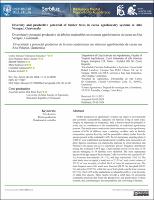Diversity and productive potential of timber trees in cocoa agroforestry systems in Alta Verapaz, Guatemala

View/
Date
27-02-2024Author
Villanueva-González, Carlos
Ruiz-Chután, José
Polesny, Zbynek
Kalousova, Marie
Lojka, Bohdan
Villanueva, Cristóbal
Sustainable development goals
ODS 8 - Trabajo decente y crecimiento económico
ODS 11 - Ciudades y comunidades sostenibles
ODS 15 - Vida de ecosistemas terrestres
Type
Artículo
Metadata
Show full item recordAbstract
Timber production in agroforestry systems can improve environmental and economic sustainability, especially for families living in rural areas. Despite its importance in Guatemala, little is known about the potential of wood and its contribution to the sustainability of traditional agroforestry systems. This study aims to analyze the timber resources in cocoa agroforestry systems (CAFS) of different ages, evaluating variables such as floristic composition, species diversity, and the potential to obtain timber from the species present in the evaluated CAFS. Twenty temporary sampling plots of 2,500 m2 were established, and dendrometric variables were measured in all plots. Species occurrence was statistically analyzed by cross-tabulation and Pearson’s Chi-square test (χ2) to determine species’ frequency distribution among the evaluated CAFS ages. Eight hundred twenty-seven trees of 38 species belonging to 19 families were identified. The most represented species in the age range of the evaluated CAFS were Gliricidia sepium (35.07 %), Swietenia macrophylla (19.11 %), and Inga sapindoides (7.62 %). The total shade trees occupied a basal area of 33.29 m2, and a total volume of 352.35 m3 was recorded, of which 148.9 m3 were for commercial use. The most frequent uses of the wood were firewood (38.21 %), thin plank (30.23 %), and poles (22.85 %), while the use of thick plank was the least common (8.71 %). The CAFS in the studied area are characterized by a wide diversity of shade tree species. These results provide a solid basis for promoting sustainable practices that foster the productivity and preservation of these systems, thus contributing to the sustainability and well-being of farmers.
Keywords
Agroforesteria||agroforestry||agrosilvicultura||agroforesterie, Árboles||trees||árvore||arbre, Diversificación||diversification||diversificação||diversification, Productividad||productivity||produtividade||productivité, Zonas rurales||rural areas||zona rural||zone rurale, Sostenibilidad||sustainability||sustentabilidade||durabilité, Diversidad de especies||species diversity||diversidade de espécies||diversité des espèces, Diversificación económica||economic diversification||undefined||diversification économique,
Delegation
Sede Central
ORCID-ID
https://orcid.org/0000-0003-4218-7945
https://orcid.org/0000-0002-5059-1975
https://orcid.org/0000-0001-7078-4064
https://orcid.org/0000-0003-0175-9847
https://orcid.org/0000-0003-3897-855X
https://orcid.org/0000-0003-4620-1441
Publisher
Revista de la Facultad de Agronomía de la Universidad del Zulia
Status
openAccess
xmlui.dri2xhtml.METS-1.0.item-uri-link
https://produccioncientificaluz.org/index.php/agronomia/article/view/41698

